Page Not Found
Page not found. Your pixels are in another canvas.
A list of all the posts and pages found on the site. For you robots out there is an XML version available for digesting as well.
Page not found. Your pixels are in another canvas.
This is a page not in th emain menu
Published:
Giacomo Balla, with his Futurist works (such as Dynamism of a Dog on a Leash), sought to depict successive positions of a moving form in one image, giving a sense of acceleration, decomposition into phases, and dynamic continuity. A similar effect has been obtained by Xavi Bou in his Ornithographies that compile sequential images of birds in flight into a single overlapping, ghost-trail pattern; each flight path becomes a visual trace in the sky. This description of the flight of birds have been researched also by Julia Daser in the dynamic sculpture Birds in Flight that explores how to compress temporal sequences spatially. Other fiction approached the theme of the representation of the movement in the fourth dimension using concepts as space-time worms or space-time sausages.
Published:
Dal cambiamento climatico a un sistema energetico sostenibile è un progetto editoriale di Gianni Comini (Dipartimento di Energia e Ambiente del Centro Internazionale di Scienze Meccaniche, CISM di Udine) e Michele Libralato (Dipartimento Politecnico di Ingegneria e Architettura dell’Università degli Studi di Udine). Secondo la missione del Dipartimento Energia e Ambiente del CISM il progetto fornisce ai non specialisti un’informazione continua e indipendente su temi quali:
Published:

Il cambiamento climatico, probabilmente il più importante dei problemi che l’umanità si trova ad affrontare, è causato dalle concentrazioni atmosferiche eccessive di “gas serra” (come anidride carbonica, metano e protossido di azoto per citare i più importanti). Questi gas hanno la poco gradita proprietà di lasciar passare le radiazioni solari in entrata ma di ostacolare le radiazioni infrarosse in uscita dalla Terra.

Gli impatti del cambiamento climatico sono ormai tali da condizionare le nostre scelte di base più elementari: come adattare l’abitazione, dove programmare le vacanze, che auto acquistare, in quale industria cercare lavoro, che cibi scegliere e quali consumi abbandonare.
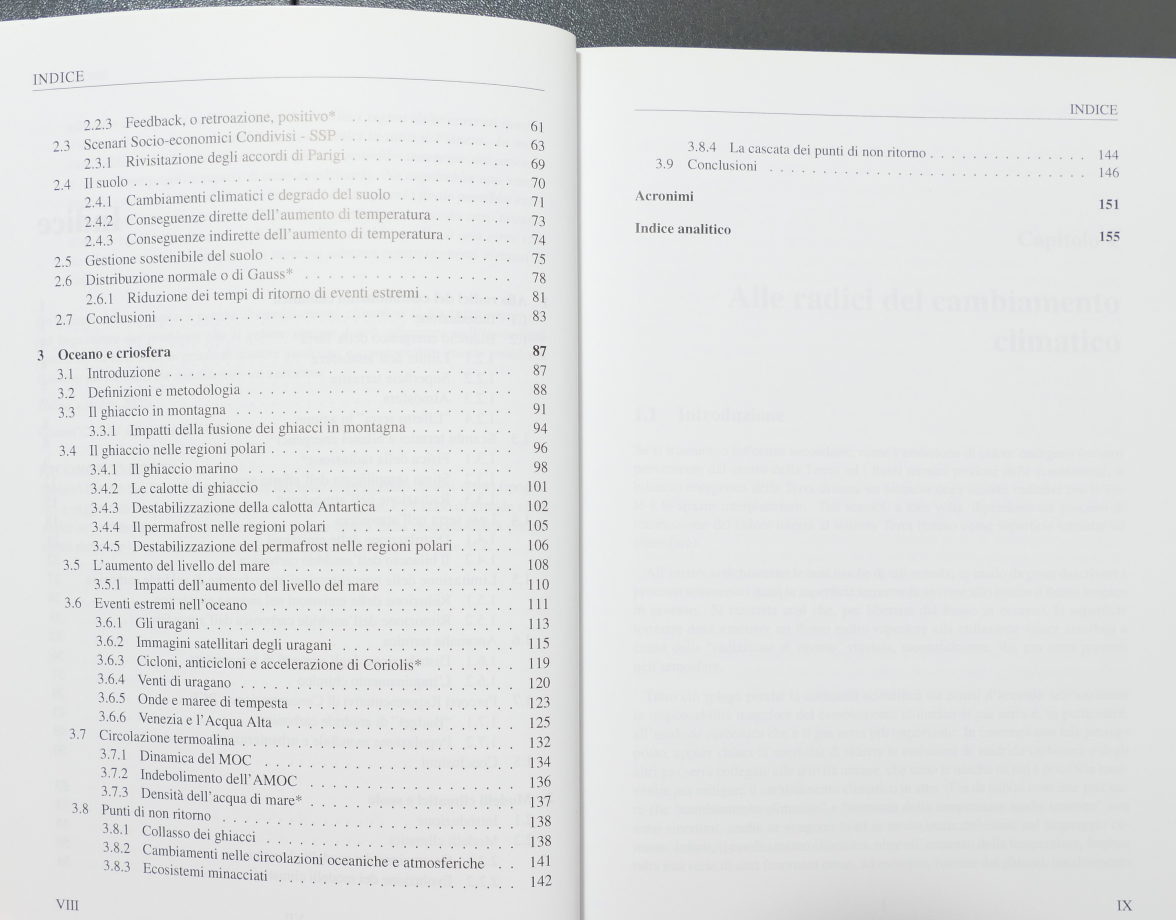
In questo quadro, il volume si propone di far risparmiare tempo e fatica a chi, pur non essendo climatologo di professione, vuole ugualmente informarsi in modo serio sul cambiamento climatico.
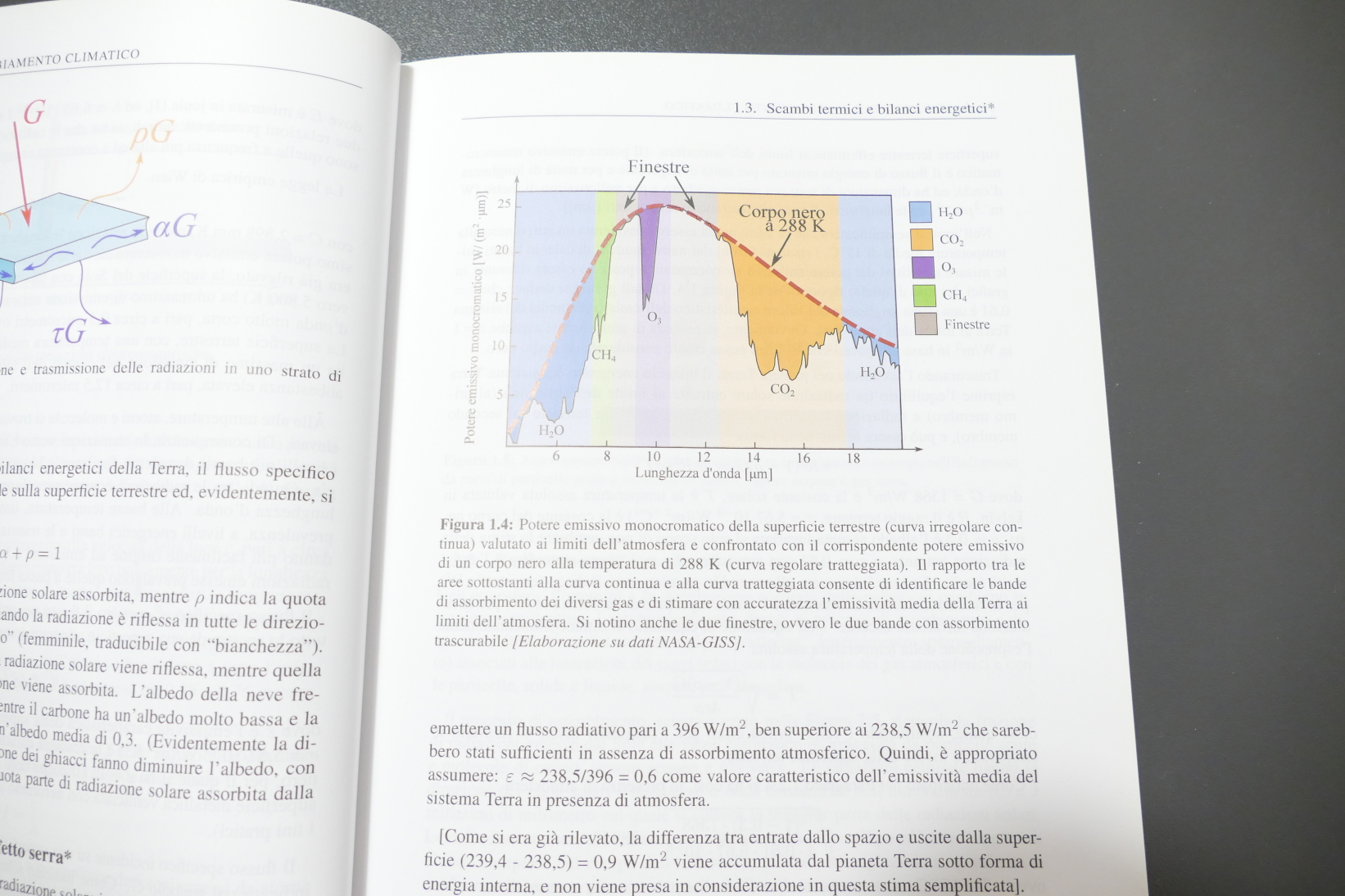
A tal fine, nel testo si sono presentati i punti chiave dei Rapporti del Comitato Intergovernativo sul Cambiamento Climatico (IPCC) e, per completare la panoramica, non si sono trascurate nemmeno le segnalazioni di rischi aggiuntivi provenienti, in “tempo reale”, da fonti molto attendibili (la rivista Nature per prima). Per facilitare la comprensione si è seguito il ben collaudato “format” dei volumi didattici: prima le conoscenze di base, successivamente le metodologie utilizzate ed alla fine la presentazione dei risultati ottenuti. Particolare cura è stata dedicata alle esigenze di render sempre note le fonti delle informazioni utilizzate e, allo stesso tempo, di spiegare e non dare mai scontate le affermazioni chiare solo agli “addetti ai lavori”. Di particolare importanza è il quarto capitolo, nel quale viene illustrato il ‘Sesto Rapporto IPCC sul cambiamento climatico – Le basi fisiche’, pubblicato il 9 agosto 2021, e sono riassunte le conclusioni della COP26, svoltasi a Glasgow dal 31 ottobre al 15 novembre 2021.
Il volume ha ricevuto diverse recensioni da specialisti del settore su blog e su riviste.
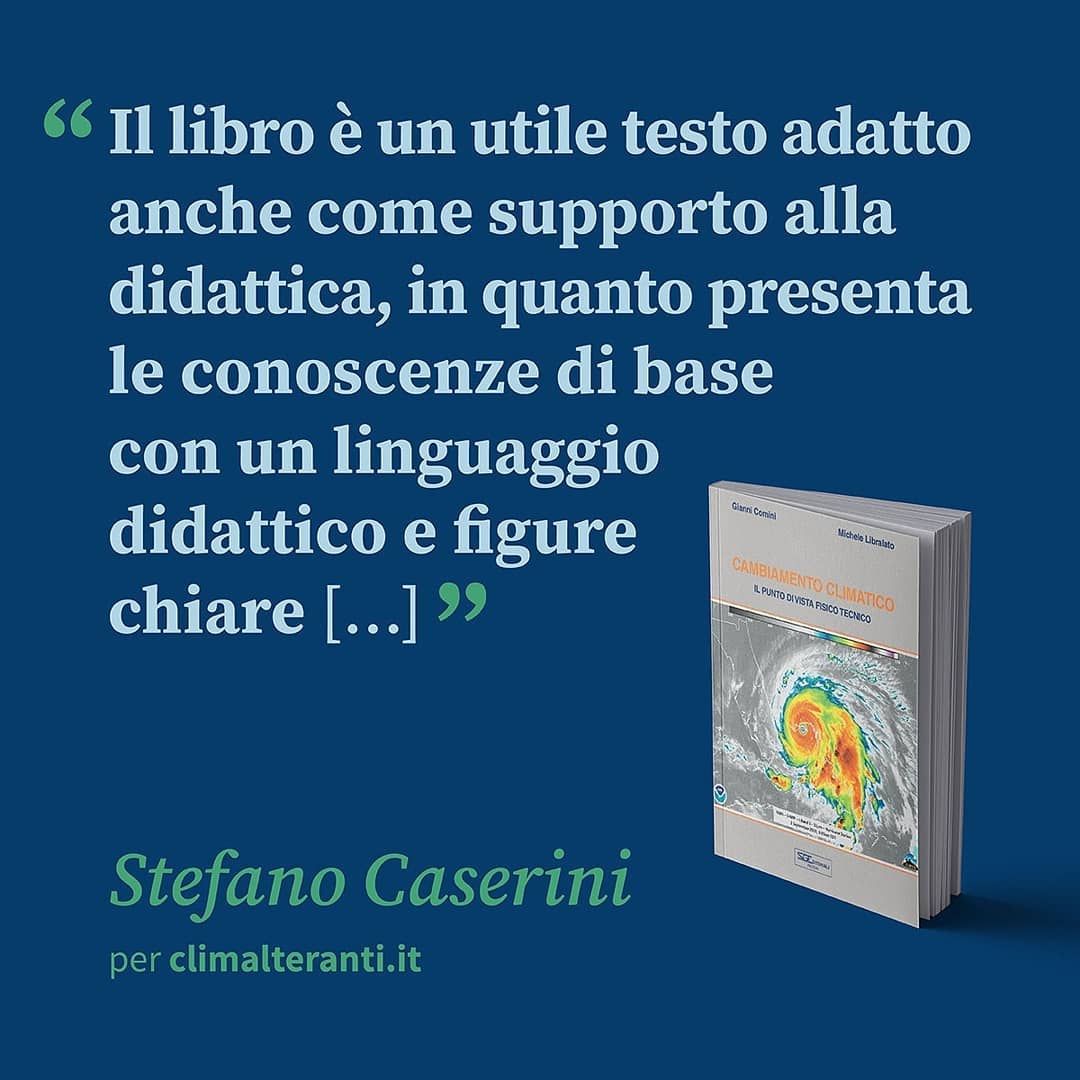
“Il libro è un utile testo adatto anche come supporto alla didattica, in quanto presenta le conoscenze di base con un linguaggio didattico e figure” Stefano Caserini per www.climalteranti.it leggi il testo integrale su climalteranti.it
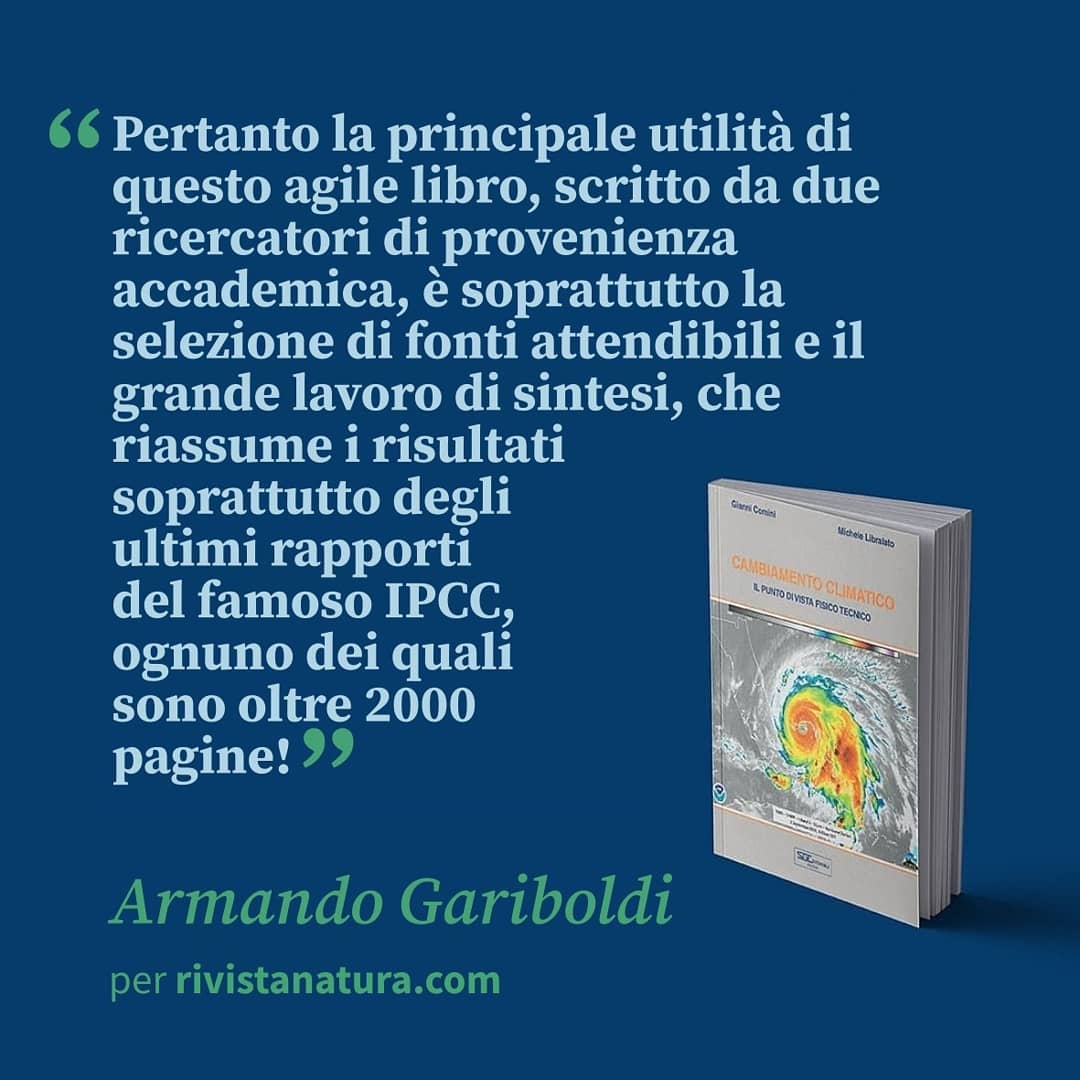
“Pertanto la principale utilità di questo agile libro, scritto da due ricercatori di provenienza accademica, è soprattutto la selezione di fonti attendibili e il grande lavoro di sintesi, che riassume i risultati soprattutto degli ultimi rapporti del famoso IPCC, ognuno dei quali sono oltre 2000 pagine!” Armando Gariboldi per rivistanatura.com Leggi il testo integrale su rivistanatura.com
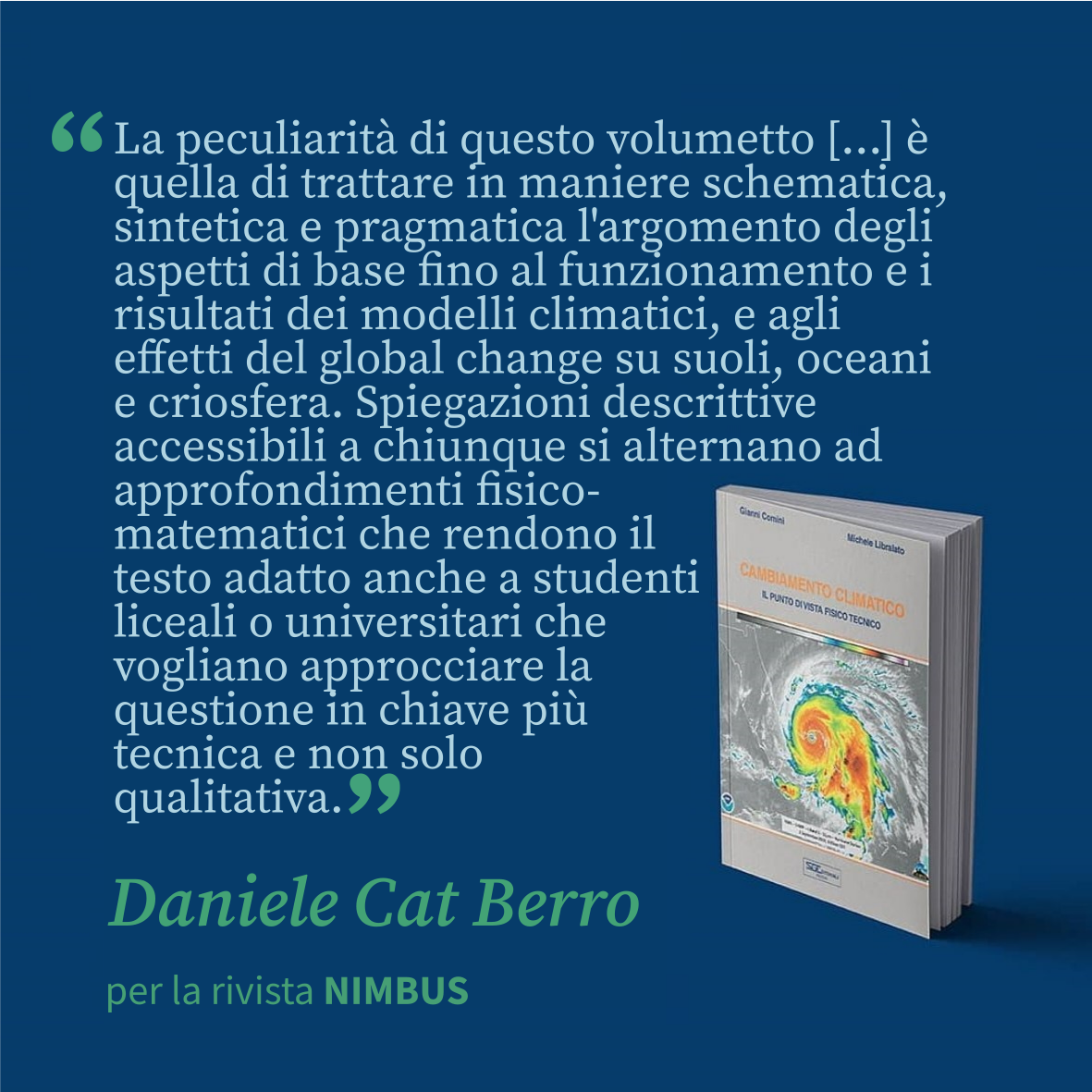
“La peculiarità di questo volumetto è quelle di trattare in maniera schematica, sintetica e pragmatica l’argomento degli aspetti di base fino al funzionamento e i risultati dei modelli climatici, e agli effetti del global change su suoli, oceani e criosfera. Spiegazioni descrittive accessibili a chiunque si alternano ad approfondimenti fisico-matematici che rendono il testo adatto anche a studenti liceali o universitari che vogliano approcciare la questione in chiave più tecnica e non solo qualitativa.” Daniele Cat Berro per la rivista Nimbus Leggi il testo integrale sul numero 85 della rivista Nimbus della Società Meteorologica Italiana
Gianni Comini è stato professore ordinario di Fisica Tecnica nelle Università di Trieste e Udine dal 1975 al 2010 e, dal 2010, è Direttore del Dipartimento di Energia e Ambiente del Centro Internazionale per le Scienze Meccaniche (CISM) di Udine.
Michele Libralato è dottore di ricerca in Scienze dell’Ingegneria Energetica e Ambientale. Dal 2016 svolge attività di ricerca nel settore della Fisica Tecnica Ambientale presso l’Università di Udine
“Il Cambiamento Climatico - Il punto di vista fisico tecnico” è edito da SGE Padova, ISBN: 888988438X (prima edizione, non disponibile)
“Il cambiamento climatico - Il punto di vista fisico-tecnico. Nuova edizione” è edito da libreriauniversitaria.it EAN:9788833594392 ISBN:8833594394
Published:
EN:
For some reason WUFIplus manual instructions to activete batch mode don’t work on every system. With this workaround it worked:
variables, click on Edit the system environment variablesEnvironment Variables...System variables in the lower half of the window, look for the Path row, click on it, then click on editNew and add the WUFIPlus.exe path, it usually is C:\Program Files (x86)\WUFI\masterWUFI\WUFIplus. If “New” is not available, add the path in the list of paths, in the variable value section, after a ;OKcmd.exe and click on Command Prompt.mwp files)cd, press space, then paste the path of the project fileswufiplus "C" "R" "filename1.mwp" "filename2.mwp" where filename1.mwp and filename2.mwp are the previously prepared project files. More files could be added after these two."C" means that WUFIplus will run all the cases in the project files listed"R" means that WUFIplus will export the results in two .txt files, one containing a report, the second containing the hourly results of the simulation If you input “R” first and then “C” wufi will not run the simulation.Is it working?
IT:
Per qualche motivo, usando alla lettera le istruzioni fornite dal manuale di WUFIplus, la modalità batch non funziona. Con questo workaround invece funziona:
variabili o ambiente , cliccare modifica le variabili d'ambiente relative al sistemaVariabili d'ambiente...Variabili di sistema nella metà inferiore della finestra, cliccare sulla riga Path, e poi su Modifica...Nuovo e aggiungere il percorso di WUFIPlus.exe, che di solito è C:\Program Files (x86)\WUFI\masterWUFI\WUFIplus, oppure, nel caso compaia solo una finestrella con due campi, inserire il percorso nel secondo campo valore variabile, dopo un punto e virgola ;OKcmd.exe e click su Prompt dei comandi.mwp)cd lasciare uno spazio e incollare il percorso della cartellawufiplus "C" "R" "filename1.mwp" "filename2.mwp" dove filename1.mwp and filename2.mwp sono dei file progetto preparati precedentemente. Si possono aggiungere altri file inserendo il loro nome, uno dopo l’altro ."C" significa che WUFIplus simulerà tutti i casi del progetto"R" significa che WUFIplus esporterà i risultati in due file .txt,uno con un report generale , l’altro con i risultati orari della simulazione Se scrivi “R” e poi “C” wufi non funzionerà.Fammi sapere se funziona!
Short description of portfolio item number 1
Short description of portfolio item number 2 
Published in Journal of Building Performance Simulation, 2019
The purpose of this article is to present and validate a computationally efficient numerical approach for the calculation of the ground-coupled heat transfer in buildings with periodic boundary conditions. When the boundary conditions of the heat transfer problem are described by periodic functions, it is possible to consider the transient state problem as a quasi-stationary problem with considerable savings in terms of computational time. The method is presented in detail from a mathematical point of view, together with a validation for two simple cases of slab-on-grade thermal losses, four comparisons with the ISO 13370:2007 procedure, a case with a complex shape and an evaluation of the computational efficiency.
Recommended citation: M. Libralato, A. De Angelis & O. Saro (2019) Evaluation of the ground-coupled quasi-stationary heat transfer in buildings by means of an accurate and computationally efficient numerical approach and comparison with the ISO 13370 procedure, Journal of Building Performance Simulation, 12:5, 719-727, DOI: 10.1080/19401493.2019.1628304 https://doi.org/10.1080/19401493.2019.1628304
Published in Proceedings of Building Simulation Applications BSA 2019, pp.191-199;, 2020
The risk analysis of moisture-related damages can potentially be carried out with the use of heat and moisture transfer simulations. These models require weather files as boundary conditions but, for most locations, the only weather files available are Typical Reference Years, for instance the TRY EN defined in accordance with EN ISO 15927-4:2005. These reference years do not provide the critical conditions that should be used in risk assessments. In this work, two procedures to define Extreme Moisture Reference Years (ERY m1 and ERY m2) are presented. ERYm1 and ERYm2 are designed to generate critical weather files to be used in simulations for the assessment of moisture related risks. The presented procedures are structure-independent and suitable for risk assessments that involve high air moisture content and low air temperature values. In order to assess the capabilities of ERY m, five types of walls with different materials are simulated, considering three Italian climates (those of Gemona del Friuli, of Legnaro and of Trento) and four wall orientations (North, East, South, West). The results of simulations with ERYm1 and ERYm2 as weather files showed higher wall moisture contents and interstitial moisture accumulation risks than those with TRY EN. This suggests that ERY m could be used as a valid alternative to the TRY EN in decision making frameworks and legislations that cannot include the ad hoc definition of a weather file for each structure, exposure and location.
Recommended citation: Libralato, Pernigotto, G., Prada, A., De Angelis, A., Saro, O., & Gasparella, A. (2020). Design and Evaluation of Extreme Moisture Reference Years for Moisture-Related Risk Assessments. Proceedings of Building Simulation Applications BSA 2019, 191–199. https://doi.org/10.13124/9788860461766_24 https://bia.unibz.it/esploro/outputs/991006493993401241
Published in Journal of Building Engineering, 2021
Wood decay risk assessment of building envelopes is commonly performed by engineers, architects and practitioners using results of Heat and Moisture Transfer (HMT) simulations and damage models. The commonly accepted HMT models use bijective sorption functions, accepting that materials reach hygrothermal equilibrium with the humidity contained in the air of the material’s pores and of the environment at a single MC. On the other hand, due to moisture hysteresis, equilibrium can be reached at different MCs for the same air condition, depending on previous equilibrium states. The aim of this work is to quantify the effect of considering hysteresis in HMT simulations and to evaluate its propagation in the risk assessment procedure for the case of wood decay. The software MATCH is used, implementation of an HMT model with hysteresis. Three timber walls are simulated in seven locations (Bolzano, Copenhagen, Hong Kong, Ottawa, Shanghai, Udine, and Vienna), first with hysteresis and then with simplified bijective sorption functions (adsorption, desorption, and mean sorption curve). MC and temperature time series are used to perform wood decay risk assessment with two damage models. The results show that the influence of hysteresis can be relevant, and that the choice of the sorption curve used in the simulations should be discussed. For the case of a CLT wall in Shanghai, simulated using the adsorption curve, a mean difference of 1.6% MC is found from the hysteresis case. This resulted in a difference of 0.7 decay rating in 10 years and 6% mass loss in 30 years.
Recommended citation: Libralato M, De Angelis A, Saro O, Qin M, Rode C (2021). Effects of considering moisture hysteresis on wood decay risk simulations of building envelopes. Journal of Building Engineering (Elsevier, 2021). https://doi.org/10.1016/j.jobe.2021.102444
Published:
This is a description of your talk, which is a markdown files that can be all markdown-ified like any other post. Yay markdown!
Published:
This is a description of your conference proceedings talk, note the different field in type. You can put anything in this field.
Undergraduate course, University 1, Department, 2014
This is a description of a teaching experience. You can use markdown like any other post.
Workshop, University 1, Department, 2015
This is a description of a teaching experience. You can use markdown like any other post.